#creating rural communities
Explore tagged Tumblr posts
Text
The one weird monopoly trick that gave us Walmart and Amazon and killed Main Street

I'm coming to BURNING MAN! On TUESDAY (Aug 27) at 1PM, I'm giving a talk called "DISENSHITTIFY OR DIE!" at PALENQUE NORTE (7&E). On WEDNESDAY (Aug 28) at NOON, I'm doing a "Talking Caterpillar" Q&A at LIMINAL LABS (830&C).

Walmart didn't just happen. The rise of Walmart – and Amazon, its online successor – was the result of a specific policy choice, the decision by the Reagan administration not to enforce a key antitrust law. Walmart may have been founded by Sam Walton, but its success (and the demise of the American Main Street) are down to Reaganomics.
The law that Reagan neutered? The Robinson-Patman Act, a very boring-sounding law that makes it illegal for powerful companies (like Walmart) to demand preferential pricing from their suppliers (farmers, packaged goods makers, meat producers, etc). The idea here is straightforward. A company like Walmart is a powerful buyer (a "monopsonist" – compare with "monopolist," a powerful seller). That means that they can demand deep discounts from suppliers. Smaller stores – the mom and pop store on your Main Street – don't have the clout to demand those discounts. Worse, because those buyers are weak, the sellers – packaged goods companies, agribusiness cartels, Big Meat – can actually charge them more to make up for the losses they're taking in selling below cost to Walmart.
Reagan ordered his antitrust cops to stop enforcing Robinson-Patman, which was a huge giveaway to big business. Of course, that's not how Reagan framed it: He called Robinson-Patman a declaration of "war on low prices," because it prevented big companies from using their buying power to squeeze huge discounts. Reagan's court sorcerers/economists asserted that if Walmart could get goods at lower prices, they would sell goods at lower prices.
Which was true…up to a point. Because preferential discounting (offering better discounts to bigger customers) creates a structural advantage over smaller businesses, it meant that big box stores would eventually eliminate virtually all of their smaller competitors. That's exactly what happened: downtowns withered, suburban big boxes grew. Spending that would have formerly stayed in the community was whisked away to corporate headquarters. These corporate HQs were inevitably located in "onshore-offshore" tax haven states, meaning they were barely taxed at the state level. That left plenty of money in these big companies' coffers to spend on funny accountants who'd help them avoid federal taxes, too. That's another structural advantage the big box stores had over the mom-and-pops: not only did they get their inventory at below-cost discounts, they didn't have to pay tax on the profits, either.
MBA programs actually teach this as a strategy to pursue: they usually refer to Amazon's "flywheel" where lower prices bring in more customers which allows them to demand even lower prices:
https://www.youtube.com/watch?v=BaSwWYemLek
You might have heard about rural and inner-city "food deserts," where all the independent grocery stores have shuttered, leaving behind nothing but dollar stores? These are the direct product of the decision not to enforce Robinson-Patman. Dollar stores target working class neighborhoods with functional, beloved local grocers. They open multiple dollar stores nearby (nearly all the dollar stores you see are owned by one of two conglomerates, no matter what the sign over the door says). They price goods below cost and pay for high levels of staffing, draining business off the community grocery store until it collapses. Then, all the dollar stores except one close and the remaining store fires most of its staff (working at a dollar store is incredibly dangerous, thanks to low staffing levels that make them easy targets for armed robbers). Then, they jack up prices, selling goods in "cheater" sizes that are smaller than the normal retail packaging, and which are only made available to large dollar store conglomerates:
https://pluralistic.net/2023/03/27/walmarts-jackals/#cheater-sizes
Writing in The American Prospect, Max M Miller and Bryce Tuttle1 – a current and a former staffer for FTC Commissioner Alvaro Bedoya – write about the long shadow cast by Reagan's decision to put Robinson-Patman in mothballs:
https://prospect.org/economy/2024-08-13-stopping-excessive-market-power-monopoly/
They tell the story of Robinson-Patman's origins in 1936, when A&P was using preferential discounts to destroy the independent grocery sector and endanger the American food system. A&P didn't just demand preferential discounts from its suppliers; it also charged them a fortune to be displayed on its shelves, an early version of Amazon's $38b/year payola system:
https://pluralistic.net/2022/11/28/enshittification/#relentless-payola
They point out that Robinson-Patman didn't really need to be enacted; America already had an antitrust law that banned this conduct: section 2 of the the Clayton Act, which was passed in 1914. But for decades, the US courts refused to interpret the Clayton Act according to its plain meaning, with judges tying themselves in knots to insist that the law couldn't possibly mean what it said. Robinson-Patman was one of a series of antitrust laws that Congress passed in a bid to explain in words so small even federal judges could understand them that the purpose of American antitrust law was to keep corporations weak:
https://pluralistic.net/2023/04/14/aiming-at-dollars/#not-men
Both the Clayton Act and Robinson-Patman reject the argument that it's OK to let monopolies form and come to dominate critical sectors of the American economy based on the theoretical possibility that this will lead to lower prices. They reject this idea first as a legal matter. We don't let giant corporations victimize small businesses and their suppliers just because that might help someone else.
Beyond this, there's the realpolitik of monopoly. Yes, companies could pass lower costs on to customers, but will they? Look at Amazon: the company takes $0.45-$0.51 out of every dollar that its sellers earn, and requires them to offer their lowest price on Amazon. No one has a 45-51% margin, so every seller jacks up their prices on Amazon, but you don't notice it, because Amazon forces them to jack up prices everywhere else:
https://pluralistic.net/2024/03/01/managerial-discretion/#junk-fees
The Robinson-Patman Act did important work, and its absence led to many of the horribles we're living through today. This week on his Peoples & Things podcast, Lee Vinsel talked with Benjamin Waterhouse about his new book, One Day I’ll Work for Myself: The Dream and Delusion That Conquered America:
https://athenaeum.vt.domains/peoplesandthings/2024/08/12/78-benjamin-c-waterhouse-on-one-day-ill-work-for-myself-the-dream-and-delusion-that-conquered-america/
Towards the end of the discussion, Vinsel and Waterhouse turn to Robinson-Patman, its author, Wright Patman, and the politics of small business in America. They point out – correctly – that Wright Patman was something of a creep, a "Dixiecrat" (southern Democrat) who was either an ideological segregationist or someone who didn't mind supporting segregation irrespective of his beliefs.
That's a valid critique of Wright Patman, but it's got little bearing on the substance and history of the law that bears his name, the Robinson-Patman Act. Vinsel and Waterhouse get into that as well, and while they made some good points that I wholeheartedly agreed with, I fiercely disagree with the conclusion they drew from these points.
Vinsel and Waterhouse point out (again, correctly) that small businesses have a long history of supporting reactionary causes and attacking workers' rights – associations of small businesses, small women-owned business, and small minority-owned businesses were all in on opposition to minimum wages and other key labor causes.
But while this is all true, that doesn't make Robinson-Patman a reactionary law, or bad for workers. The point of protecting small businesses from the predatory practices of large firms is to maintain an American economy where business can't trump workers or government. Large companies are literally ungovernable: they have gigantic war-chests they can spend lobbying governments and corrupting the political process, and concentrated sectors find it comparatively easy to come together to decide on a single lobbying position and then make it reality.
As Vinsel and Waterhouse discuss, US big business has traditionally hated small business. They recount a notorious and telling anaecdote about the editor of the Chamber of Commerce magazine asking his boss if he could include coverage of small businesses, given the many small business owners who belonged to the Chamber, only to be told, "Over my dead body." Why did – why does – big business hate small business so much? Because small businesses wreck the game. If they are included in hearings, notices of inquiry, or just given a vote on what the Chamber of Commerce will lobby for with their membership dollars, they will ask for things that break with the big business lobbying consensus.
That's why we should like small business. Not because small business owners are incapable of being petty tyrants, but because whatever else, they will be petty. They won't be able to hire million-dollar-a-month union-busting law-firms, they won't be able to bribe Congress to pass favorable laws, they can't capture their regulators with juicy offers of sweet jobs after their government service ends.
Vinsel and Waterhouse point out that many large firms emerged during the era in which Robinson-Patman was in force, but that misunderstands the purpose of Robinson-Patman: it wasn't designed to prevent any large businesses from emerging. There are some capital-intensive sectors (say, chip fabrication) where the minimum size for doing anything is pretty damned big.
As Miller and Tuttle write:
The goal of RPA was not to create a permanent Jeffersonian agrarian republic of exclusively small businesses. It was to preserve a diverse economy of big and small businesses. Congress recognized that the needs of communities and people—whether in their role as consumers, business owners, or workers—are varied and diverse. A handful of large chains would never be able to meet all those needs in every community, especially if they are granted pricing power.
The fight against monopoly is only secondarily a fight between small businesses and giant ones. It's foundationally a fight about whether corporations should have so much power that they are too big to fail, too big to jail, and too big to care.

Community voting for SXSW is live! If you wanna hear RIDA QADRI and me talk about how GIG WORKERS can DISENSHITTIFY their jobs with INTEROPERABILITY, VOTE FOR THIS ONE!

If you'd like an essay-formatted version of this post to read or share, here's a link to it on pluralistic.net, my surveillance-free, ad-free, tracker-free blog:
https://pluralistic.net/2024/08/14/the-price-is-wright/#enforcement-priorities
#pluralistic#Robinson-Patman Act#ftc#alvaro bedoya#monopoly#monopsony#main street#too big to jail#too big to care#impunity#regulatory capture#prices#the american prospect#Max M Miller#Bryce Tuttle#a and p#wright patman
2K notes
·
View notes
Text









Greetings from West Arbor!
It took ages, but after tons of tweaking and bug-fixing I've finally finished my first Sims 3 custom world!
West Arbor is a coastal town surrounded by forested hills and open water with rural, suburban, and urban areas. It has plenty of lots and activities for all sorts of gameplay, including clubs, coffeeshops, parks, resorts, stables, and much more.
Info:
-145 total lots (52 residential, 66 community, 27 empty) -2048x2048 world size -Populated and unpopulated versions -Populated version has 16 households (56 sims and pets) -Required expansions: World Adventures, Ambitions, Late Night, Generations, Pets, Supernatural, Seasons, Showtime, University, Island Paradise (All of them except Into the Future) -Recommended stuff packs: Town Life & High End Loft (Neither are necessary and are just used for décor) -Store content used: Rim Rockin' Basketball Hoop -CC Free
Special thanks to my playtesters for helping catch all the issues and oversights I missed, and to mariesimming and Cawster for their Create-A-World resources.
Download:
Sim File Share
MEGA
Thanks to everyone who downloads my world, I hope you enjoy playing in it! Feel free to message me if you have any issues.
#simblr#sims3#ts3#the sims 3#sims 3 create a world#s3cc#sims 3#sims 3 caw#sims 3 custom world#sims 3 builds#sims 3 world#West Arbor#sims#create a world
674 notes
·
View notes
Text
"Rewilding in Scotland has created a more than 400% increase in jobs, research has found amid calls for it to continue.
Research by Rewilding Britain shows 35 jobs have been created at one site alone in the Highlands since 2008.
The research found there has been a 412% increase in jobs at 13 major rewilding projects covering almost 60,000 hectares, including sites owned or managed by charities, communities, private landowners, and public bodies.
Full-time equivalent jobs across the sites increased from 24 before rewilding to 123, across sectors including hospitality, estate management, ecology, environmental monitoring, rewilding interventions, recreation, and education.
The largest recorded rise in jobs was at Trees for Life’s 4,000-hectare Dundreggan estate near Loch Ness in the Highlands, a former deer stalking estate.
Since 2008, some 35 jobs have been created in addition to the sole previous position, while volunteer numbers have risen from zero to 100.
A rewilding centre was opened at the site last year and an open invitation has been extended to Hollywood star Leonardo DiCaprio to visit it after he backed a campaign for Scotland to become the world’s first “rewilding nation”.
All the sites are more than 100 hectares in size and are part of the Rewilding Network managed by Rewilding Britain.
The research found combined volunteer numbers at the sites increased from zero to 435...
The Scottish Government has been urged to commit to nature recovery across 30% of land by restoring habitats including peatlands, native woodlands, wetlands, rivers and seas, with no loss of productive farmland.
Kevin Cumming, rewilding director at Rewilding Britain and deputy convener of the Scottish Rewilding Alliance, said: “These remarkable job creation figures show how rewilding can turbo-charge social and economic benefits, while offering hope for reversing biodiversity loss and tackling climate breakdown.
“This is yet another powerful illustration of why the Scottish Government should declare Scotland a rewilding nation.
“The opportunity is huge – for jobs and local economies, better health, food production, access to fresh water and clean air.”
The alliance’s Rewilding Nation Charter – including representations from more than 20 organisations – has been signed by thousands of people since it launched in the spring.
A Scottish Government spokesperson said: “Restoring Scotland’s natural environment is a key way that we can help address the twin challenges of nature loss and climate change, including many of the interventions championed by the Scottish Rewilding Alliance.
“We welcome this evidence of employment in rural communities and will consider this research as we continue to work towards our commitment to protect and restore 30% of Scotland’s land and seas for nature.
“Our £65 million Nature Restoration Fund has committed nearly £40 million since 2021 to unlock the full potential that nature restoration projects can bring to communities.
“The fund has supported local businesses, helped landowners with pollinator projects to boost food production and supported improved access to green spaces throughout Scotland, alongside restoration of our marine environment.”
The charter can be viewed at www.rewild.scot/charter."
-via The Independent, June 19, 2024
#scotland#rewilding#united kingdom#uk#biodiversity#scottish#environment#ecology#ecopunk#solarpunk#ecotourism#good news#hope
1K notes
·
View notes
Text
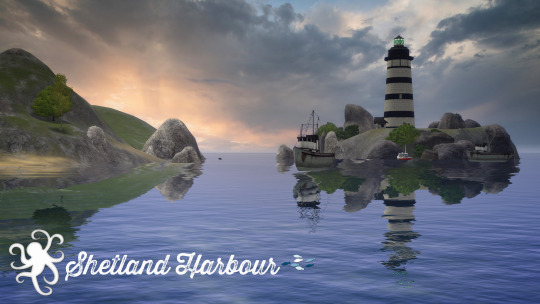
A BRAND NEW SIMS 3 WORLD : SHETLAND HARBOUR
And here we are ... At last :D
10 years ago, Rope crafted a remarkable world, inspired by Starlight Shores, and generously given away to the community : Brightwater.
We embraced this gift, transforming and reshaping it, creating an island to eliminate distant terrain, and thus, Shetland Harbour was born ...
While many creators have fashioned stunning Sims 3 worlds with a Northern charm—like Saaqartoq, Greymont Bay, Lillebror, or Plymouth Isles—ours, stands a little apart.
Shetland Harbour is a unique blend : a touch of Aurora Skies, a hint of Moonlight Falls, and a dash of the unfortunate Barnacle Bay, all interwoven with our own vision of course. It is a vast yet easily navigable world, balanced between lightness and richness, featuring nearly all the Rabbit Holes the game offers.
Our aim was to craft a cohesive and vibrant world, one that feels alive and contemporary, with harmonious architecture and a spirit that invites exploration and delight :)
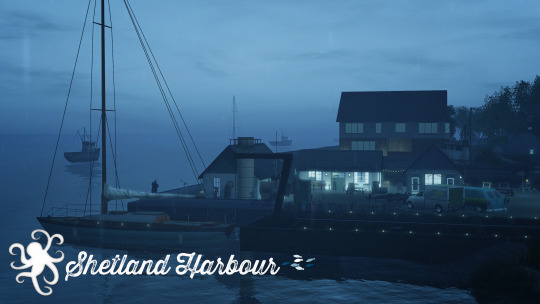
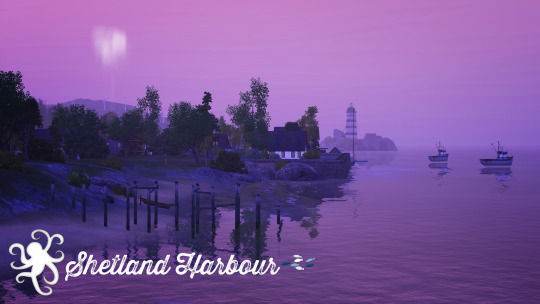
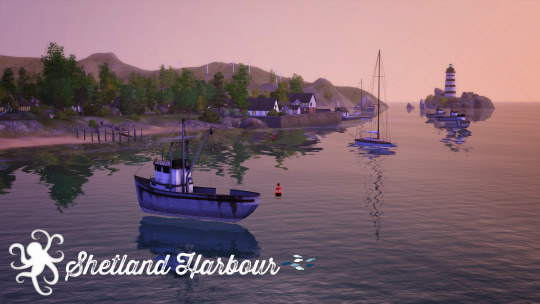
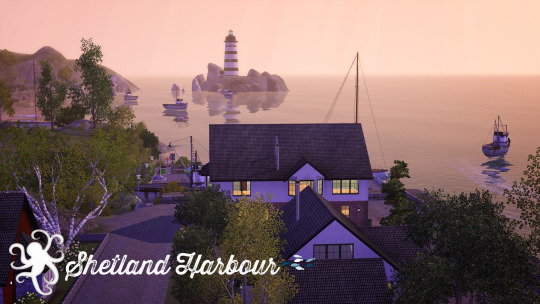
Welcome to Shetland Harbour, a picturesque coastal town nestled between rolling green hills and a fantastic bay … It is a beautiful medium/large-sized world, a community nestled on its own secluded island, accessible only by ferry. The town is known for its charming cobblestone streets, a vibrant fish market, and a rich history dating back centuries, dotted with quaint cottages, a bustling coast, and a grand lighthouse standing guard at the harbor’s entrance ...
This hidden gem is a haven for sheep, but don't let that fool you – Shetland Harbour is far from a sleepy place. With its rich maritime history, the town offers a unique blend of tradition and vibrant local culture.
Designed to capture the essence of a northern European island, Shetland Harbour offers a self-contained community with 100 lots in total : 65 residential lots + 35 community lots. Each Lot ( except the Old Renovated Factory ) is fully furnished.
In addition, there are multiple sheep ( all by Murfeel ) fields here and there – the latter being especially dear to the local culture, a close-knit community, where the ocean's presence is always felt and the simplicity of rural life is celebrated.
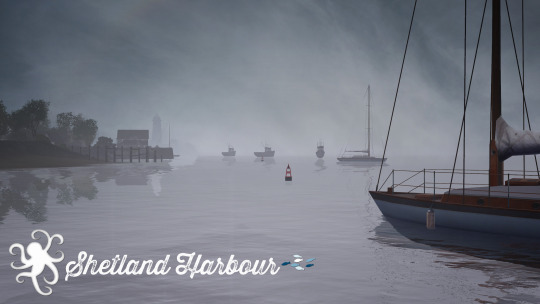

Shetland Harbour combines a lively downtown with peaceful suburbs and serene neighborhoods, featuring quaint cottages, charming gardens, and scenic paths through lush greenery.
The town's historic churches, like Old Church, Albert Church or Lux Chapel, are steeped in tales of ancient rituals and ghostly apparitions ... Albert Church, built on a Druidic site, is haunted by druid spirits, while Lux Chapel is known for the ghost of a sailor, seen on stormy nights ...
The mysterious stone circle inside the Graveyard, Ghost Place, adds to the island's mystical allure. Rumored to be a portal to another realm, it activates during celestial alignments, with visitors reporting strange occurrences. Town elders speak of a prophecy foretelling the return of ancient spirits and the awakening of the island's mystical powers. Signs include a rare star alignment, the stone circle's awakening, and three chosen individuals with the island's ancient bloodline ...
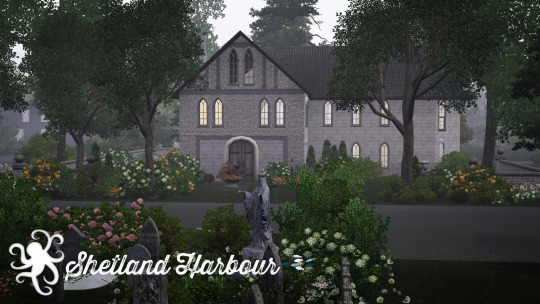
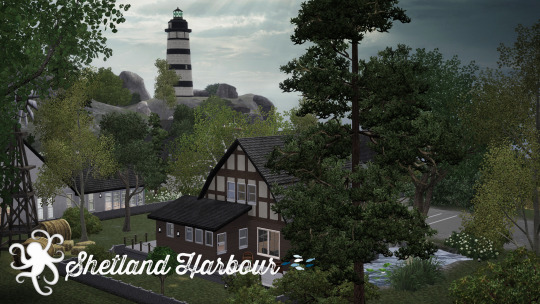
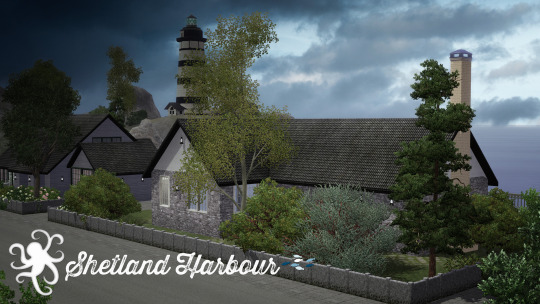

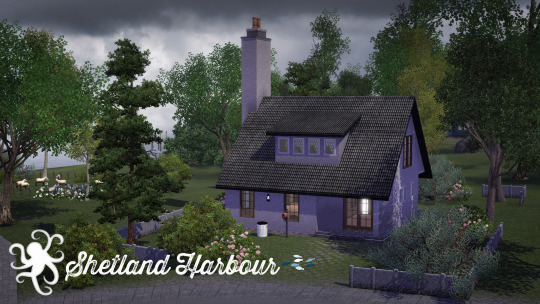
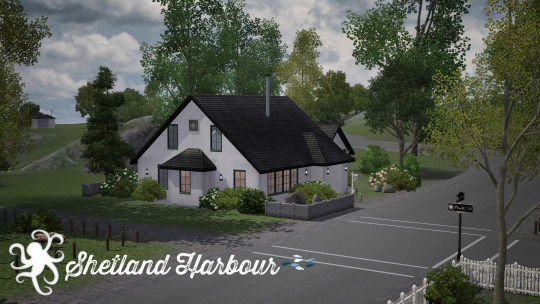
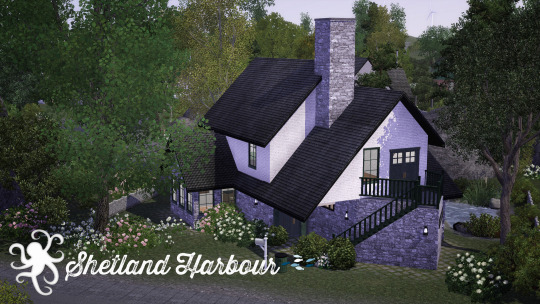
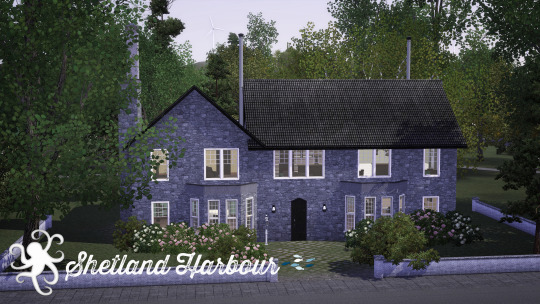
• Harbor Bay : The central feature of Shetland Harbour is its expansive bay. The bay is a natural harbor with calm, crystal-clear waters, making it ideal for fishing and sailing. It is surrounded by gently sloping hills and cliffs that provide stunning vistas of the sea. The marina is bustling with fishing boats, sailboats, and yachts sometimes … It’s the hub of maritime activity, with a fish market ( aka Grocery Store ), boat repairs, and a sailing club ( aka Business and Journalism Center )
• Lighthouse District : Right beside the Harbour, stands the Lighthouse Point, this district features historical homes and buildings, including a Norman cottage, a strange Diner and higher into the Hills, a fantastic museum dedicated to the town’s maritime history and a recent Hospital ready to welcome all the citizens of Shetland Harbour :)
• Beaches : The Coastline is dotted with sandy beaches, perfect for beachcombing, picnics, and bonfires. These areas are popular spots for locals and tourists alike. And you may want building some Coastal Houses for your Sims which is possible almost all alongside the sea ;)
• Old Town : The heart of Shetland Harbour is the Old Town, characterized by cobblestone streets, historic buildings, and a charming town square. Shetland Harbour's downtown area is a kinda picturesque pedestrian square, and quaint paths perfect for leisurely strolls …The Old Town includes the Town Hall, the Old Toad, the Talking Dog, a Fish and Chips, and even a Geek Store, all of them under the shadow of one of the oldest shop of the Island : the Elixirium ...
• Rolling Hills : Surrounding the town are rolling green hills covered in wildflowers and dotted with grazing sheep. These hills are perfect for hiking and offer panoramic views of the town and the bay. Beware of the fog !
• Forests and Woodlands : To the north of the town are more dense forests and woodlands with waterfalls upstream of the river which separates part of the island. These areas are home to various wildlife and provide a natural retreat for the residents. There are several well-maintained trails for hiking and exploring :)
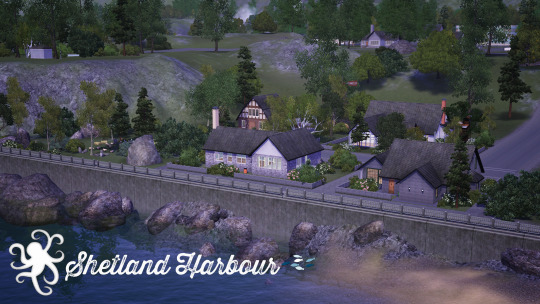
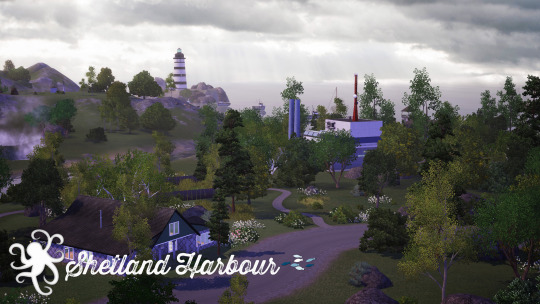
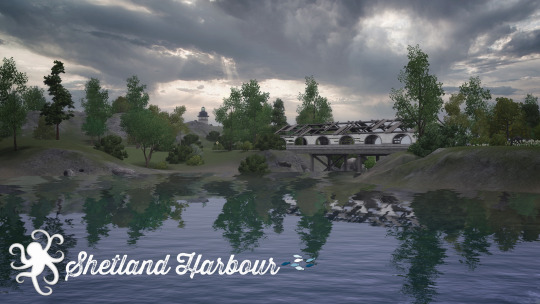
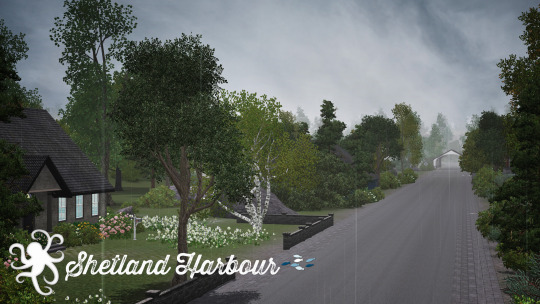
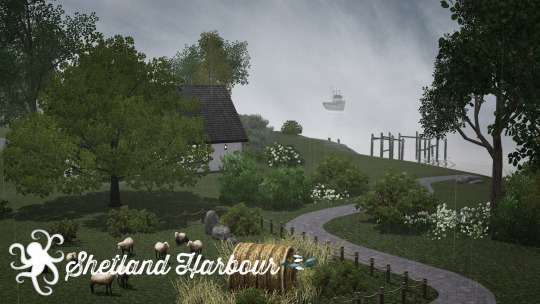
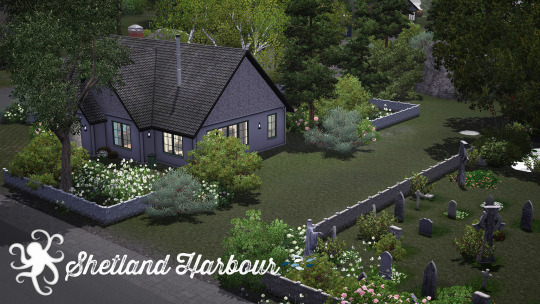
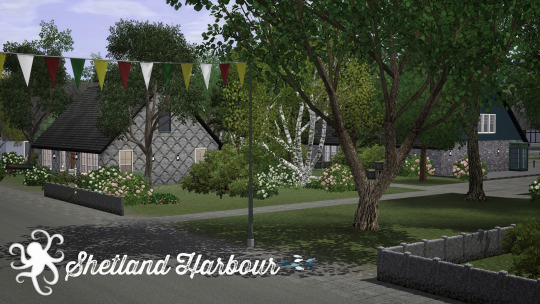
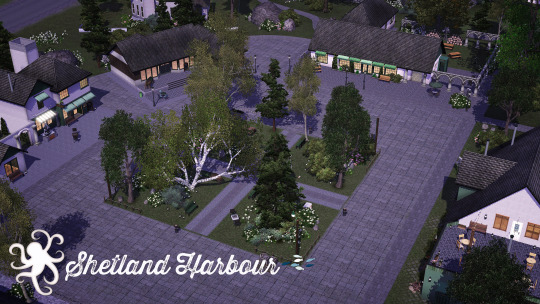
Come and explore Shetland Harbour all your content ... Whether you're building your dream home, running a local business, or simply soaking in the serene atmosphere, this unique town promises endless possibilities and a truly captivating experience ...
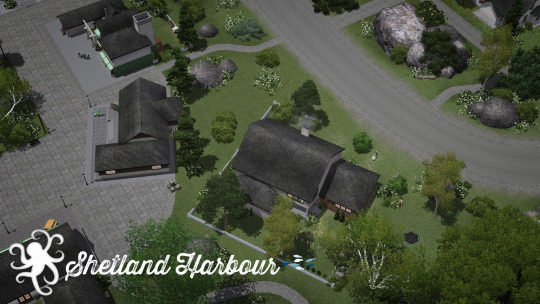
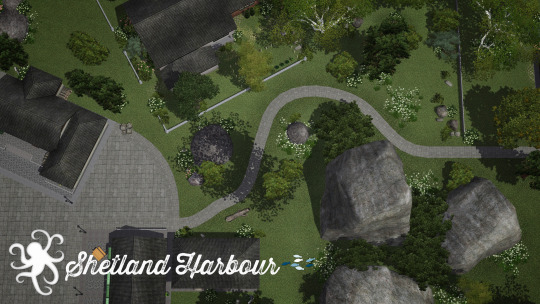
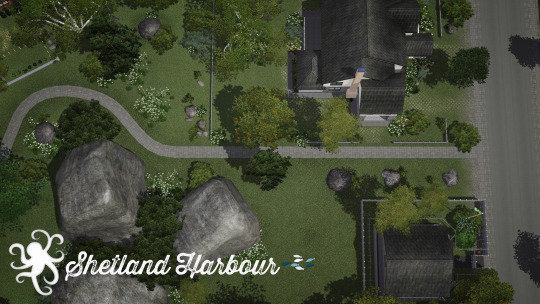

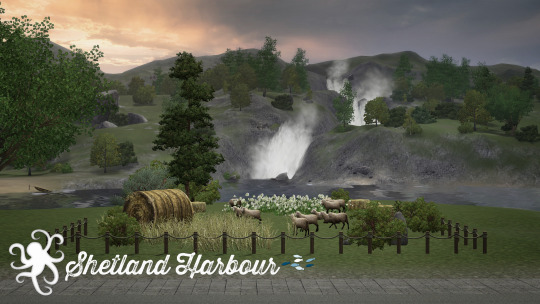
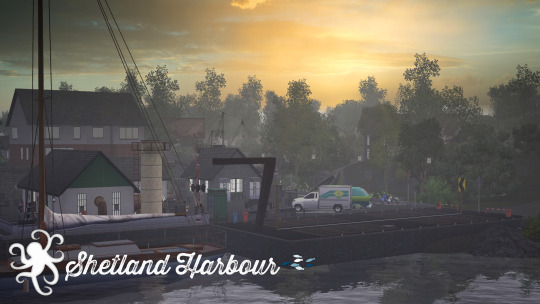
Download Shetland Harbour today and start your new adventure!
\o/
- - - - - - - - - - - - - - - - - - - - - - -
IMPORTANT : Before downloading Shetland Harbour !!!
Shetland Harbour contains custom content. As much as we try to include them into the world building process, we learned with time the necessity of providing a list those items. No worries, we used the same cc creators as usual and added 2 or 3 more. Such as the grey/dark roof we made, based on the terracotta roof of the game and the Wood walls you'll find on different lots, the same as the ones of Oaksoak Hollow ... Or more important, the boats used in the world and of course ... The sheeps ! All you need should be included and/or available down here ;)
1) the ANTS & CC :)
ANTS stand for Absolute Necessary Things & Stuff to enjoy Shetland Harbour :)
Download ANTS and CC ( both are needed to have all the right textures, the right look and feel of Shetland Harbour )
You will need too some of our Rabbit Holes
Not mandatory but nice : our 88 Patterns mostly brick, masonry, concrete and wood ;) A bit of fabric & paper too ...
ATTENTION : if you have played with one of our Worlds, you might see duplicate files. We try to use the same objects as much as possible. Of course, you don't have to install twice. Skip whatever you already have. We use Blams objects for some Sims 3 objects ... so if you already have those objects from any other means, just skip ;)
CREDITS & THANKS due to all the following creators :
ATS, Noir and Dark Sims, pitheinfinite, Brunnis-2, Blams, CycloneSue, HydrangeaChainsaw, Leroy157, Lisen801, Murfeele, Nilxis, PotatoBalladSims, Qahne, TheJim07, Mammut ( from BlackSimsZoo ) BlueCoco, BuffSumm, JomSims, Ladesire, Mutske
2) the Saved Games
They are in the same page than Shetland Harbour itself. You have the choice between Unpopulated and Half-populated. Whatever you choose, we always strongly advice with a save game ;) But as far we know, once we delivered a World, it is entirely up to you to begin a new adventure and make your own challenges with your own Sims :D
Download a save game
3) the Lots ( both residential & community )
Quite a bursting town, Shetland Harbour has 100 lots : 65 residential and 35 community and very important : many small sheep fields ( visitors not allowed com lots )
Download ALL the lots
Some lots are Maxis ones we modified, some lots are our own creations, and for the others, they come mostly from MTS ;) And we are very grateful to those creators who always offer a special flavor to our Worlds :)
CarlDillynson - Bellakenobi - Bast - MySimRealty - stonee206 - Norn - Cutbacks - Ferguson Avenue - SimplySimlish - hazelnutter100 - PolarBearSims - RubyRed2021 - CircusWolf - Moihi - Lasciel
Well, it is time for discovery now and you are ready for sure ! We wish you all the best, all the fun with your new life in Shetland Harbour !
Download Shetland Harbour World
PS : Shetland Harbour is a medium/large sized world of 88MB, and has been tested 1 week long on both Mac and Pc ;)
xoxo - blackgryffin
#the sims 3#sims 3 gameplay#sims 3#thesims3#ts3#sims3 worlds#sims3 build#shetland harbour#sims 3 world#sims3 cc#k hippie#k-hippie
925 notes
·
View notes
Note
I saw how you said that describing the PRC as capitalist betrays a lack of understanding of capitalism and I actually really liked how well you explained that being against capitalism isn't proper Marxism/communism so I was wondering if you could open that post on understanding capitalism a bit more! Only if you're okay with it, of course!
Eventually I should do a real proper Effortpost on this with all the graphs and figures to really drive home the point that I'm making, but very briefly since it's getting late here:
In Marx's time, capitalism was an emergent societal mode of production that was closely entertwined with the enclosure movement and the industrial revolution. On the level of labor, it saw the decline of peasant and artisan labor and the rise of proletarianization, and with it the tendencies of mechanization and rationalization of production (e.g. de-skilling of manufacturing and measurement of efficiency by the labor-hour)
On a consistent historical level, from Marx's time to ours, capitalism has been characterized by the role of liquidity holders (e.g. banks, joint stock companies, investment funds &c) in investigating growth industries and investing in them for the purpose of greater profit. Notably: the demand from financial actors for returns on their balance-sheets is constant, regardless of the state of the development in any given productive market. Meanwhile the nature of industrial development is that it happens in fits and starts, in great surging advances followed by relatively stagnant plateaus. The results of this mismatch are twofold:
First, as Lenin chronicled, it leads for a demand to engage in imperialist expansion to open new markets and seek new profits that way. The other, arguably larger and more important frontier however is that of speculation. Because the inflation of the value of an asset creates purchasing power in and of itself in the short term, which is maintained on balance sheets so long as the arrears on credit derived on it keeps getting paid on a notional path to amortizaiton.
The tendency in capitalism since Marx's time has been the ever-growing importance of these two dynamics and the gradual receding of the importance of low-elasticity economic activity like manufacturing goods.
The tendency of imperialist expansion within capitalism has created a networked global bourgeoisie throughout the financial capitals of the world who extract rentier profits from the various rural peripheries of the global south, and the speculative nature of investment capital in the late 20th and early 21st century defines the quality of the "capitalist develpment" we see in bourgeois states in the contemporary global south: namely, extremely uneven development between rural and urban, trapping of the labor force in a holding-pattern of low-pay low-skill work such as textile production or low-end manufacturing (e.g. Bangladesh and Malaysia) while their capitals enjoy wealth near that of the imperial core, with relatively very high-paying jobs in the knowledge industries (this should ring a bell with India lol). Any country that is actually ruled by its bourgeoisie will follow this pattern, because financialized paper profits are larger (in nominal terms) than the highly investment-intensive industrial development that has gone on in the PRC under the stewardship of the Party. However the result is that the PRC has relatively low inequality among middle-income countries and the technological benefits of the industrialization led by cities is beginning to flow to rural China, which is what allowed them to lift 800 million people out of extreme poverty, something that has yet to happen in actually capitalist bourgeis states like India.
280 notes
·
View notes
Text
horror of 2025
here's the list (hoping i get every movie but mostly will be kinda focusing on the ones i'm either excited for or is super popular)
the wolfman - leigh whannell's take on the classic
final destination: bloodlines - tormented by recurring violent nightmares, stefanie returns home to break the cycle
black phone 2: sequel
sax xi: eleventh installment in the saw franchise
28 years later - it's been three decades since the rage virus escaped a laboratory and some groups have been able to live amongst the infected but when they leave the safety of their island they'll discover dark secrets
m3gan 2.0 - sequel
companion - after being invited to a weeekend trip at her new beau's lakeside estate, iris uncovers a terrible secret
they follow: sequel to it follows
frankenstein: guillermo's del toro's take on the original
the strangers: chapter 2 - sequel
the strangers: chapter 3 - end of a trilogy
scary movie: return to the horror spoof series
sinners - trying to leave their troubled lives behind, twin brothers return to their hometown to start again, only to discover that an even greater evil is waiting to welcome them back
untitled jordan peele film - plot tba
poohniverse: monsters assemble - a team of evil childhood cartoon characters i didn't know we needed but i guess we're getting one
vicious - a young woman must spent the night fighting for her existence as she slips down a disturbing rabbit hole contained inside a mysterious gift from a late-night visitor
blade - i mean i hope so but i'm not sure if we're actually getting it this year
the bride - in the 1930s, a lonely frankenstein travels to chicago to seek the aid of dr. euphronius in creating a companion for himself. they murder a young woman and the bride is born
scary stories to tell in the dark 2 - sequel
thanksgiving 2 - sequel
the auditors - nikki, grappling with post-job loss financial strain, inadvertently ignores the fine print of their MDPOPE purchase, and their descent into horror begins with the arrival of the auditors who subject them to torture
grind - a group of college students host a midnight grindhouse film festival. they discover a cursed arthouse horror movie called the creeping chaos. in screening the movie, they unleash absolute mayhem
you take can now - plot tba
scream 7 - plot tba
kraken - marine biologist johanne is doing research on a fish farm in vangshe, a rural community located by the fjord. when she encounters strange occurances along with two brutal deaths, she discovers that a mythical creature rests
the woman in the yard - a mysterious woman who repeatedly appears in a family's front yard, often giving chilling warnings, and leaving residents to question her identity, motive, and potential danger
i know what you did last summer - reboot of classic
fear street: prom queen - prom season at shadyside high is underway, but when an outsider is unexpectedly nominated to the court, and other girls start disappearing, the class of '88 is in for a hell of a prom night
until dawn - live action of the video game
let the evil go west - a railroad worker stumbles upon a fortune teller in distubring circumstances and horrifying visions drive him towards madness
the monkey - when twin brothers hal and bill discover their father's old monkey toy in the attic, a series of gruesome deaths start occurring around them
hell house llc: lineage - fifth installment
screamboat: a late night boat ride turns into a desperate fight for survival in new york city when a mouse becomes a monstrous reality (what the fuck)
body farm - the forester johann only wants to warn his ex-wife sophie of a forensic research facility, but when he gets to the site, fast-growing slime has infested the corpses of the dead and brings them to life
i know exactly how you die - when his slasher-fiction novel manifests in real life, rian burman has to finish his story without getting his protagonist killed
le fanu's carmilla - retelling of the book
devil's work - when a couple, traveling on their vacation, meet a desperate girl seeking for her missing sister, they encounter terror and up as hostages to a twisted family and their son
the seductress from hell - hollywood actress undergoes a horrific transformation after being pushed to the edge by her husband
hyde - modern take on the classic novella by robert louis stevenson
crawlers - in the year 2030, a zombie pandemic decimates the united states population. american surviors rush to mexico where a plateau is believed to be zombie free
the children of the woods - in january 1999, a group of five disappeared after they went into the woods of york, south carolina for a camping trip, their story is being told 25 years later (inspired by blair witch project)
the dreadful - in the backdrop of the war of roses, anne and her mother-in-law morwen who live in solidary, run into a man from their past
presence - a family moves into a suburban house and become convinced they're not alone
victorian psycho - winifred notty arrives at a remote gothic manor, and as she assimilates into life, staff members begin to disappear
heart eyes - when the heart eyes killer strikes seattle, a pair of co workers pulling overtime are mistaken for a couple by the couple-hunting killer. now they must spend their valetine's day running for their lives
peter pan's neverland nightmare - after her brother michael is abducted by "the boy who won't grow up," peter pan, wendy darling goes on a rescue mission
224 notes
·
View notes
Text


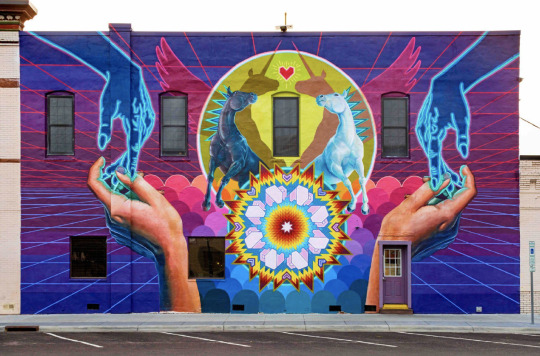
. ݁₊ ⊹ . ݁˖ . ݁ If you want a giant sparkly unicorn rainbow Pride mural like this in your own town...we could help make that happen! . ݁₊ ⊹ . ݁˖ . ݁
High school GSA club students in rural Vermillion, South Dakota were awarded one of our grants in 2022. They collabed with local artist group Mural On the Wall to create an amazing Pride mural on the side of a local downtown restaurant, with over 70 community members contributing and over 40 taking part in their community painting day.
If that wasn't rad enough on its own: thanks to this art and other murals that decorate the streets, the town of Vermillion won the #1 spot in a Reader’s Choice award by USA Today for small towns with the best art scenes!
🟣 One of the GSA club members said, "For me, the significance of the mural is representing the unity between the Indigenous people, the LGBTQ+ community, & other marginalized groups facing oppression in South Dakota.”
🟣 The GSA VP said, "In times of uncertainty and intolerance towards minority groups in our community, murals like these display our unity and support, spreading a message of love, pride, and hope. I am proud to have been a part of this creative process.”
🟣 Another GSA club member reflected, "As a young woman pursuing a design career, this mural project was instrumental for many reasons. Not only did it present me with the experience to see and be a part of a large scale creative project from beginning to end, but it also helped me connect with my community and contribute to making my hometown more inclusive and beautiful."
🟣 And the GSA club president said, "As a queer person in a place like rural South Dakota, it is easy to feel underrepresented and left out. My hope is that this project provides visibility and reminds anyone struggling that there are still people on your side."
We want to make more of this happen! If you have an idea to support LGBTQ+ youth in your own community, apply now through May 5th for an It Gets Better: Changemakers grant of up to $10,000: itgetsbetter.org/changemakers
309 notes
·
View notes
Text
Identity Health Clinic, the only queer health focused primary care and gender clinic in Alaska, serving the entire state, is in major needs of funds to complete it's expansion. Alaska has a great deal of queer people in rural communities and out int he bush who need the care that Identity provides, especially in a time when the entire LGBTQ community, but especially the trans community is under attack.
Please give what you can if you can and share this to spread the word!
#fundraising#trans health#transition care#transgender#queer health#bisexual#lesbian#gay#lgbtqia health#queer community#lgbtq community#lgbtqia#pride#pride 2025#gender clinic#queer#healthcare#alaska#us politics#us healthcare#real life writes the post
131 notes
·
View notes
Text

Created sometime between 1380 and 550 BC, the Uffington White Horse is a prehistoric hill figure on the upper slopes of Whitehorse Hill. Formed from deep trenches filled with crushed white chalk, the 110m figure is annually re-chalked and restored by volunteers, though it used to be more of a community event, every seven years.
In 1736, Francis Wise wrote: "The ceremony of scouring the Horse, from time immemorial, has been solemnized by a numerous concourse of people from all the villages roundabout."
When the work was done, a rural festival was held, sponsored by the lord of the manor, though this tradition came to an end toward the end of the 19th century. It's not the only such white horse figure in Britain, though it's by far the oldest, and inspired many others with entirely different designs. (source)
#bronze age#iron age#uffington white horse#chalk horse#prehistoric hill figure#prehistory#archaeology#history
101 notes
·
View notes
Text
"Growing up, Mackenzee Thompson always wanted a deeper connection with her tribe and culture.
The 26-year-old member of the Choctaw Nation said she grew up outside of her tribe’s reservation and wasn’t sure what her place within the Indigenous community would be.
Through a first-of-its-kind program, Thompson said she’s now figured out how she can best serve her people — as a doctor.
Thompson is graduating as part of the inaugural class from Oklahoma State University’s College of Osteopathic Medicine at the Cherokee Nation. It’s the first physician training program on a Native American reservation and in affiliation with a tribal government, according to school and tribal officials.
“I couldn’t even have dreamed this up,” she said. “To be able to serve my people and learn more about my culture is so exciting. I have learned so much already.”
Thompson is one of nine Native graduates, who make up more than 20 percent of the class of 46 students, said Dr. Natasha Bray, the school’s dean. There are an additional 15 Native students graduating from the school’s Tulsa campus.
The OSU-COM graduates include students from 14 different tribes, including Cherokee, Choctaw, Muscogee, Seminole, Chickasaw, Alaska Native, Caddo, and Osage.
Bray said OSU partnered with the Cherokee Nation to open the school in 2020 to help erase the shortage of Indigenous doctors nationwide. There are about 841,000 active physicians practicing in the United States. Of those, nearly 2,500 — or 0.3 percent — are Native American, according to the Association of American Medical Colleges.
When American Indian and Alaska Native people visit Indian Health Service clinics, there aren’t enough doctors or nurses to provide “quality and timely health care,” according to a 2018 report from the Government Accountability Office. On average, a quarter of IHS provider positions — from physicians to nurses and other care positions –are vacant.
“These students here are going to make a generational impact,” Cherokee Nation Principal Chief Chuck Hoskin Jr. told the students days before graduation. “There is such a need in this state and in this region for physicians and this school was created out of a concern about the pipeline of doctors into our health system.”
The Cherokee Nation spent $40 million to build the college in its capital of Tahlequah. The walls of the campus feature artifacts of Cherokee culture as well as paintings to remember important figures from Cherokee history. An oath of commitment on the wall is written in both English and Cherokee.
The physician training program was launched in the first year of the pandemic.
Bray said OSU and Cherokee leadership felt it was important to have the school in the heart of the Cherokee Nation, home to more than 141,000 people, because students would be able to get experience treating Indigenous patients. In Tahlequah, students live and study in a small town about an hour east of Tulsa with a population of less than 24,000 people.
“While many students learn about the problems facing these rural communities,” Bray said. “Our students are getting to see them firsthand and learn from those experiences.”
While students from the college are free to choose where to complete their residency after graduation, an emphasis is placed on serving rural and Indigenous areas of the country.
There’s also a severe lack of physicians in rural America, a shortage that existed before the COVID-19 pandemic. The Association of American Medical Colleges has projected that rural counties could see a shortage between 37,800 and 124,000 physicians by 2034. An additional 180,000 doctors would be needed in rural counties and other underserved populations to make up the difference.
Bray said OSU saw an opportunity to not only help correct the underrepresentation of Native physicians but also fill a workforce need to help serve and improve health care outcomes in rural populations.
“We knew we’d need to identify students who had a desire to serve these communities and also stay in these communities,” she said.
Osteopathic doctors, or DOs, have the same qualifications and training as allopathic doctors, or MDs, but the two types of doctors attend different schools. While MDs learn from traditional programs, DOs take on additional training at osteopathic schools that focus on holistic medicine, like how to reduce patient discomfort by physically manipulating muscles and bones. DOs are more likely to work in primary care and rural areas to help combat the health care shortages in those areas.
As part of the curriculum, the school invited Native elders and healers to help teach students about Indigenous science and practices...
Thompson said she was able to bring those experiences into her appointments. Instead of asking only standard doctor questions, she’s been getting curious and asking about her patient’s diets, and if they are taking any natural remedies.
“It’s our mission to be as culturally competent as we can,” she said. “Learning this is making me not only a better doctor but helping patients trust me more.”
-via PBS NewsHour, May 23, 2024
#indigenous#native american#cherokee#choctaw#cherokee nation#medical school#united states#doctors#medical news#medical student#cultural competence#cultural heritage#public health#health care#medicine#good news#hope#oklahoma
1K notes
·
View notes
Text
A 7-Part Worldbuilding Template
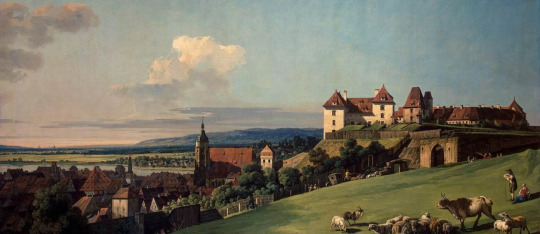
PART 1: The Basics
What is your world called?
Estimate its population:
In one sentence, describe your world:
Is it set on: Earth; Alternate Earth; Not Earth / Another planet
PART 2: Geography
THE NATURAL WORLD Flora & Fauna; Creatures; Landscape; Diseases
How was the world created? How long ago was it created?
How do the laws of physics work?
How does the solar system move? What celestial beings exist (suns, stars, moons, etc.) and how do they relate to the world?
Flora & Fauna
How does the flora differ from region to region?
Do any plants have special or magical properties? Are any dangerous?
Creatures
What kind of wildlife roams which parts of your world? Where are they most commonly found?
How did the wildlife evolve?
Do mythical creatures such as dragons exist? How do they fit into the ecosystem?
Landscape
Where are the mountain ranges? Rivers? Forests? Deserts? Seas?
How does the terrain interact with its inhabitants?
Are there any “natural wonders” in your world? How were they formed?
Diseases
What natural diseases have evolved over time?
How are they transmitted?
How has this affected population growth?
LOCATIONS OF SIGNIFICANCE Capital City; Flags & Symbols
What are the major cities in your world? Ports? Most populated metropolises?
Is your world split geographically? (e.g. rural and urban, north and south, etc.) If so, how?
Capital City
What is the capital city of the world?
Why is it the capital?
Flags & Symbols
How does each city choose to represent itself (crest, flags, signature colors)?
WEATHER
What are the processes of your world that drive weather and ocean patterns?
Are certain regions more vulnerable to certain weather conditions?
Climate
How does the climate differ in each region?
What are the seasons like in your world? How many seasons are there?
PART 3: People
RACES & SPECIES Physical Build; Mannerisms & Etiquette; Customs & Rituals; Festivals
What intelligent species or races populate your world? Dwarves? Elves? Xenomorphs? Other? How did they come to exist?
How does each race or species perceive each other? How do they co-exist?
Physical Build
What do the inhabitants of your world look like? Do they have any distinguishing features?
What is the societal standard for beauty? How might this differ in each region of the world?
Mannerisms & Etiquette
What is the code of conduct between people of different ranks or classes? People of different cities or regions? Elders?
How do people in your world convey non-verbal boredom? Disbelief? Happiness? Respect?
What would be a gesture that is universally insulting in your world?
What etiquette exists in different parts of your world?
Customs & Rituals
Are there any rites of passages in your world? “Coming of age” celebrations? If so, what age marks the transition from child to adult?
What traditions surround death and burial? What about engagements and proposals of marriage?
Festivals
What are the important festivals of your world?
Why are they celebrated?
LANGUAGES Sayings; Accents; Greetings
How many languages exist in your world? How did they originate?
Which language is spoken most? Is there a universal language?
How do naming conventions differ in each region?
Sayings
What are common sayings? Idioms? Insults? “Untranslatable” words that only a certain group of people would understand?
Accents
If different languages exist, how does this affect the accents in your world? What do the accents say about the person (place of origin, social class, level of education, etc.)?
Greetings
How do people of the same race greet each other? How do people of different races greet one another?
Is there an informal and formal way to greet others depending on the level of familiarity (i.e. friends, acquaintances, elders, superiors, etc.)? What are the proper forms of address?
SOCIAL FRAMEWORKS Class or Caste Systems; Family Structure; Marriage
What social frameworks underlie the communities in your world?
What are the social taboos? What would one need to do in order to be kicked out of society?
Class or Caste Systems
Is there a class system? If so, how much emphasis does society place on it?
What are the tell-tale signs that a person belongs to a certain class?
How does class affect professions and trades in your world? Can anyone become a priest or a wizard, for example — or is it a privilege restricted to certain members of the hierarchy?
Family Structure
What is the normal family unit?
What is the social system within a family unit in your world? Patriarchal? Matriarchal?
What constitutes a good father? A good mother? A good child?
Marriage
How is marriage defined in your world? Is marriage a civil or religious institution?
Do people marry for love? If not, why do they marry?
PART 4: Civilization
HISTORY
How did civilization begin?
When was the earliest known record of history?
What were the significant wars that have taken place on your world’s soil? How have they shaped the present?
Can your world’s history be divided into significant eras (e.g. Georgian, Victorian, Edwardian, etc.)?
Myths
What myths exist in your world to explain the cosmos? How might this have in turn shaped religion?
How were stories passed through generations?
CULTURE Literature, Art & Music; Clothing; Cuisine
Is national culture and history a source of pride or shame in your world? How is it preserved?
What are some things that define each culture? What would a person from a certain city, region, or country be proudest of?
Literature, Art & Music
What is the role of the arts in your world’s culture? How is it perceived by society and how has it evolved?
Who are some celebrated or noted artists in history? What they known for?
How might the arts have changed as a result of outside influences (from other regions, cities, races, etc.)?
Are any of the arts taboo? If so, why?
Clothing
What is the customary dress? Is it gendered? If so, how?
What is considered fashionable and how does this differ from region to region?
How does the clothing one wears reflect status?
What is the dress code for each profession? How strictly followed must it be?
Cuisine
What are the regional dishes? How might this differ depending on the climate and environment?
Is there a difference between what the poor and the rich eat? What is considered a luxurious food? What is considered a staple food?
How are mealtimes approached? Is there a set hour to be at the table? Are there traditions that precede or follow a meal?
RELIGION Gods & Deities; Holy Texts; Significant Prophets
How do people worship in your world?
When and where do people worship?
Gods & Deities
Who are the major and minor gods that people worship?
What function do the gods serve in society?
Holy Texts
What (if any) holy texts exist?
How well-known are the scriptures? Would people of all ages be able to recite them on the spot if asked ?
Significant Prophets
Who are the important religious figures in the world?
For what reason are they significant?
EDUCATION
Does formal education exist? If so, who can access it? The rich? The clergy? Everyone in the general population?
If magic exists in your world, how is it studied? Do schools exist to train it?
What are literacy rates among the general population? How does this affect communication and the distribution of information?
LEISURE
How do people spend their leisure time in your world? What forms of entertainment are most common?
Are there any organized sports in your world? How might its rules and regulations differ from the ordinary?
PART 5: Technology, Magic & Weapons
MAGIC SYSTEMS Rules of Magic; Practitioning Magicians
For what purpose is magic used in your world? Who can use it?
What limits are there to its power? What are the consequences of using it?
What is the history of magic and magicians in your world?
How does society view magic? Positively? Negatively? As the Other?
Rules of Magic
How does magic work in your world? Where does it come from?
Is there a language that’s needed in order to call forth magic? If so, what are its roots?
Is magic regulated in any way? What is the governing body?
Practitioning Magicians
What are magicians’ status in society? Are they trusted advisors of kings or charlatans on the road?
How many magicians exist in your world? How do they perceive one another?
TECHNOLOGY
How advanced is the technology in your world? How does it work?
How does technology impact the different parts of society? Transportation? Communication? Medicine?
How does magic and technology interact and co-exist? Is it a rivalry? A co-op? Are there rules and regulations?
WEAPONRY Signature Weapons; Common Weapons
What weapons are predominant in your world (ranged, combat, anti-gravity, etc.) and why?
Who makes the weapons? How do they work? Is it easy to obtain them?
Signature Weapons
Are there special weapons (e.g. Thor’s Hammer)?
How are they made? How many of them exist in the world?
Common Weapons
Are there professions that necessitate the bearing of weapons?
What about religions?
PART 6: Economy
ECONOMICS
On which economic system does your world operate? A market economy? Feudalism? Socialism?
Is there a central bank?
How does the government regulate businesses?
TRADE & COMMERCE Currency; Major Imports & Exports; Natural Resources
How is trade facilitated? Is it carried out by traveling merchants? By a guild? Are there auctions?
What cities, countries, or regions are allies? Trade partners? How has this changed throughout history?
How is the soft power of a region, city, or country determined?
Currency
Is there a universal currency? If not, what are the regional currencies? What is the valuation?
How is the currency circulated and what are the denominations?
Can the currency be broken down into units (dollars, cents, dimes, quarters)?
Major Imports & Exports
What are the major exports of the region or city? Imports? How might this have evolved throughout history?
Does a particular region specialize in particular trade (i.e. livestock, weaponry, etc.)? Why?
Natural Resources
What resources are natural in each part of your world?
How does this affect trade and trade relationships?
TRANSPORTATION
How easy it is to travel within a city and outside of a city? What modes of transportation exist (horse, anti-gravity car, etc.)?
How is information disseminated all over your world (ink and paper, owl, newspaper, messenger)?
BUSINESS
What crafts or trades are highly valued in your world?
Are some professions considered more elite or respectable than others? How so?
How do people advance in their fields? Are there apprenticeships? How easy is social mobility?
What is the normal work schedule for the average person? What is the average income?
PART 7: Politics
GOVERNMENT
What is the form of government? Is it a monarchy? Republic? Empire? Theocracy?
What are the responsibilities of the government? How far does the government’s sphere of influence spread (magic, religion, etc.)?
How is the government perceived? Is it trusted by the people or is there tension?
LAW Justice Systems; War Systems
What is the rule of law in your world? How is law enforced? What are the most important laws?
What are the punishments for breaking the law?
Justice Systems
What is the legal process in your world? How are people tried?
How does magic fit into the legal system? Is it above the law?
War Systems
How is war declared? Is there a formal process that a country must go through in order to engage in war?
What is the command structure of the army?
How big is the army? Is it composed of humans? Non-humans? Both?
Source ⚜ More: Writing Worksheets & Templates Writing References: Plot ⚜ Character ⚜ Worldbuilding
#worldbuilding#writing reference#dark academia#spilled ink#writeblr#literature#fiction#writers on tumblr#writing prompt#writing#on writing#writing tips#writing advice#writing inspiration#writing ideas#writing inspo#novel#story#booklr#bookblr#creative writing#bernardo bellotto#writing resources
187 notes
·
View notes
Text
I really love my little rural queer community. I feel like rural places get written off as being a bit backwards, but there are so many people here who are working so hard to build a community and to make the world a better place.
You don’t need to be in a city to build community, and sometimes all it takes is a few people to come together to create something real and amazing
113 notes
·
View notes
Text
Things Biden and the Democrats did, this week #7
Feb 23-March 1 2024
The White House announced $1.7 Billion in new commitments from local governments, health care systems, charities, business and non-profits as part of the White House Challenge to End Hunger and Build Healthy Communities. The Challenge was launched with 8 billion dollars in 2022 with the goal of ending hunger in America by 2030. The Challenge also seeks to drastically reduce diet-related diseases (like type 2 diabetes). As part of the new commitments 16 city pledged to make plans to end hunger by 2030, the largest insurance company in North Carolina made nutrition coaching and a healthy food delivery program a standard benefit for members, and since the challenge launched the USDA's Summer EBT program has allowed 37 states to feed children over the summer, its expected 21 million low income kids will use the program this summer.
The US House passed a bill on Nuclear energy representing the first update in US nuclear energy policy in decades, it expands the Nuclear Regulatory Commission and reduces reducing licensing fees. Nuclear power represents America's single largest source of clean energy, with almost half of carbon-free electricity coming from it. This bill will boost the industry and make it easier to build new plants
Vice President Harris announced key changes to the Child Care & Development Block Grant (CCDBG) program. The CCDBG supports the families of a million American children every month to help afford child care. The new changes include capping the co-pay families pay to no more than 7% of their income. Studies show that high income families pay 6-8% of their income in childcare while low income families pay 31%. The cap will reduce or eliminate fees for 100,000 families saving them an average of over $200 a month. The changes also strength payments to childcare providers insuring prompt payment.
The House passed a bill making changes to the Small Business Administration’s 8(a) program. The 8(a) is an intensive 9 year program that offers wide ranging training and support to small business owners who are socially and economically disadvantaged, predominantly native owned businesses. Under the current structure once a business reaches over 6.8 million in assets they're kicked off the program, even though the SBA counts anything under $10 million as a small business, many companies try to limit growth to stay on the program. The House also passed a bill to create an Office of Native American Affairs at the SBA, in order to support Native-owned small businesses.
The White House and HUD announced steps to boost the housing supply and lower costs plans include making permanent the Federal Financing Bank Risk Sharing program, the program has created 12,000 affordable housing units since 2021 with $2 billion and plans 38,000 additional units over ten years. As well as support for HUD's HOME program which has spent $4.35 billion since 2021 to build affordable rental homes and make home ownership a reality for Americans. For the first time an administration is making funds available specifically for investments in manufactured housing, $225 million. 20 million Americans live in manufactured housing, the largest form of unsubsidized affordable housing in the country, particularly the rural poor and people in tribal communities.
The Department of Energy announced $336 million in investments in rural and remote communities to lower energy costs and improve reliability. The projects represent communities in 20 states and across 30 Native tribes. 21% of Navajo Nation homes and 35% of Hopi Indian Tribe homes remain unelectrified, one of the projects hopes to bring that number to 0. Another project supports replacing a hydroelectric dam in Alaska replacing all the Chignik Bay Tribal Council's diesel power with clear hydro power. The DoE also announced $18 million for Transformative Energy projects lead by tribal or local governments and $25 million for Tribal clean energy projects, this comes on top of $75 million in Tribal clean energy projects in 2023
Transportation Secretary Pete Buttigieg put forward new rules to ensure airline passengers who use wheelchairs can travel safely and with dignity. Under the planned rules mishandling a wheelchair would be a violation of the ACAA, airlines would be required to immediately notify the passenger of their rights. Airlines would be required to repair or replace the wheelchair at the preferred vendor of the passenger's choice as well as provide a loaner wheelchair that fits the passenger's needs/requirements
The EPA launched a $3 Billion dollar program to help ports become zero-emission. This investment in green tech and zero-emission will help important transportation hubs fight climate change and replace some of the largest concentrations of diesel powered heavy equipment in America.
the EPA announced $1 Billion dollars to help clean up toxic Superfund sites. This is the last of $3.5 billion the Biden administration has invested in cleaning up toxic waste sites known as Superfund sites. This investment will help finish clean up at 85 sites across the country as well as start clean up at 25 new sites. Many Superfund sites are contained and then left not cleaned for years even decades. Thanks to the Biden-Harris team's investment the EPA has been able to do more clean up of Superfund sites in the last 2 years than the 5 years before it. More than 25% of America's black and hispanic population live with-in 5 miles of a Superfund site.
Bonus: Sweden cleared the final major barrier to become NATO's 32nd member. The Swedish Foreign Minster is expected to fly to Washington to deposit the articles of accession at the US State Department. NATO membership for Sweden and its neighbor Finland (joined last year) has been a major foreign policy goal of President Biden in the face of Russian aggressive against Ukraine. Former President Trump has repeatedly attacked NATO and declared he wants to leave the 75 year old Alliance, even going so far as to tell Russia to "do whatever the hell they want" with European NATO allies
#Thanks Biden#Joe Biden#Politics#US politics#Democrats#Climate change#end hunger#hunger#proverty#disability#native Americans#tribal rights#clean energy#child care#housing#housing crisis
774 notes
·
View notes
Text
hi! if ur in canada the postal workers are going on strike again this friday. that is may 23 2025! why this is important:
this is a fight by workers against the canadian state to keep the postal service from being gutted and privatized, as profits from package delivery move to private companies like Amazon
postal workers are proposing tons of plans to keep post offices relevant in the internet era especially in rural areas, like serving as community hubs, offering postal banking, and doing check-ins on elders—the government and canada post management want to scrap the whole thing for parts
the current defunding of public services in canada like education, healthcare, and now the postal service enables increased military spending to meet NATO commitments, making these public sector fights an anti-imperialist issue
despite the importance of this battle and the viciousness of the enemy, workers are held back from fighting all-out by the legal labour relations system which makes it extremely hard to win by outlawing solidarity strikes and incentivizing high-level union bureaucrats to submit to back-to-work legislation
postal workers need public support to stand a chance of winning this battle—when they were on strike in december as part of this same fight, they were receiving only slightly upwards of $200 a week in strike pay while being constantly vilified by the media and in some cases, being arrested
what you can do, on your own or ideally with a political organization of the working class:
learn about the postal workers' demands directly from the source, and about the events of their recent strike in december from working-class media so that you can have accurate conversations with the people in your life about this strike
take some time this week to create visible public support for postal workers in your community, such as by putting up supportive posters on community mailboxes—creating this kind of community support was crucial for giving education workers the confidence to execute their illegal strike in 2023. here is an example design
raise the issue of supporting postal workers in your union, or talk to people you know in unions about doing the same—in particular, public sector unions need to be actively pushed to stand in solidarity with each other right now
find your nearest canada post distribution center and go to the picket line on friday! bring snacks, cards, donations, homemade signs, union flags—and talk directly with workers about what the strike means for them
organize public outreach to build support for the postal workers' demands—it can be as simple as printing out a petition and spending a couple hours standing outside your local grocery store with some friends collecting contact information, or as involved as a fundraising campaign to supplement local strike pay
okay thanks for reading :)
59 notes
·
View notes
Text
Hello everyone! Our heads still aren't above the water after our heating troubles from last winter - quite literally, since our basement is now flooding because of the snow melting - and it's never easy for me to bring this up, but we could really use some help. We've been without heating for two whole months now because of this!
Thank you!
xx Sophie
***
Four years ago, my husband and I moved into a crumbling historical rural schoolhouse near the Arctic, with the intent of turning it into an art residency for queer and trans artists. We actually welcomed our first artist guests last year! This was going great, until the heating bills literally doubled in 2022 because of the geopolitical situation. To add to this situation, our basement flooded twice last year, destroying our furnace and drying up our savings.
Then starting last December, a record-shattering cold wave paralyzed our country and more specifically our region, which recorded some of the coldest temperatures on the planet, for several weeks. At the same time, the radiators of our old house that dated from the 70s decided to give up. We had to get new ones installed in emergency, to avoid further tragedies.
For the past few weeks, as the sole provider for our growing family, I've been trying to make up for these events by pulling all-nighters, scraping pennies and trying to sell as many books as I could. However, even with time extensions, bill deadlines are approaching and I must face the fact that there is no way we can save our home without some help.
(...)
Despite barely paying a living wage, we believe in the work that we do. The well-being of trans and queer communities is what drives us to create art and share our spaces. Our wish is to keep creating despite these events. However, this might not be possible if we lose our home.
349 notes
·
View notes
Text
Wheel of Time musings/drama ahead
I really hate to stir the pot (I actually love it) but the Wheel of Time community on Tumblr vs. on Facebook is really telling about the kind of people that use each as their main form of social media. For context, I've read all of the books twice over. I have followed a few WoT groups on facebook for many years, even before there was talk of a possible future TV series, and have followed quite a few WoT blogs here in the recent years, starting when we got some of our first previews of season 1.
I admit that season 1 felt a little lacking. There was a lot of new acting, the future of the show was in question due to potential lack of interest, and I think the direction of the show reflected that timid approach to the series. Season 2 was a complete turn-around, the acting improved incredibly (Egwene in the Damane kennels is the best example I can think of off-hand, pretty sure I cried the first time I saw it), the characters really felt much more fleshed out, and the show felt like it was definitely creating it's own style. Season 3 so far is the best yet, by a mile, and I am counting down the seconds until next episode. I had to watch the first episode twice in a row because it just felt like SO MUCH to process and I couldn't believe how they packed so much into one episode.
Anyway, nowadays I spend 90%+ of my social media time on Tumblr, and rarely touch anything else. Every post here about Wheel of Time is intrigued about new plot twists that were developed for the show, excited about new actors joining the cast every season (I was unsure about Shoreh Aghdashloo for Elaida but after ONE episode, I can see she's gonna be awesome), interested about new tidbits or weird things (Moghedien's fingers in the mouth thing???), and just generally excited about the show.
Facebook is the complete opposite side of the coin. Every time I open Facebook, it's just complaint after complaint. "that's not how Perrin and Faile met", "that's not how Rand got that scar", etc. etc. etc. ENDLESSLY. They refuse to enjoy the show because it's not a sentence-by-minute adaptation of the books, and instead want to just endlessly drag it through the mud and bitch about how it's "too woke". It's so trashy and I hate it, and it really shows that every fandom has its neckbeards that are just awful people.
I LOVE that the show has incredible diversity in the cast. I grew up in a rural part of America that is 95%+ white, and when I started reading the books as a young teen, I just assumed every character was white unless it explicitly said otherwise and didn't think anything of it. Almost none of the characters look like what I envisioned, but seeing it come to life on TV has made the series feel so much more alive. of COURSE not everyone is white, the books have characters from all over the world, it only makes sense that there would be many ethnicities and cultures. If it didn't, that would be fucking weird???? I LOVE that the show has a lot of new actors that we have never seen before. I knew within the first 2 episodes that Zoe Robins was a GREAT pick for Nynaeve, and she's only gotten better from there. I LOVE that the gay subtext is part of the show. I LOVE that women in the series are powerful and well-written. I LOVE that the special effects are exciting but not the star of the show. I LOVE that they don't feel the need to hold the hand of the viewer in every regard, and leave some things to mystery.
In conclusion, It is such a fantastic show and I'm so happy to see new WoT content, and I am so thankful for the enthusiastic support Tumblr has for it! :)
57 notes
·
View notes